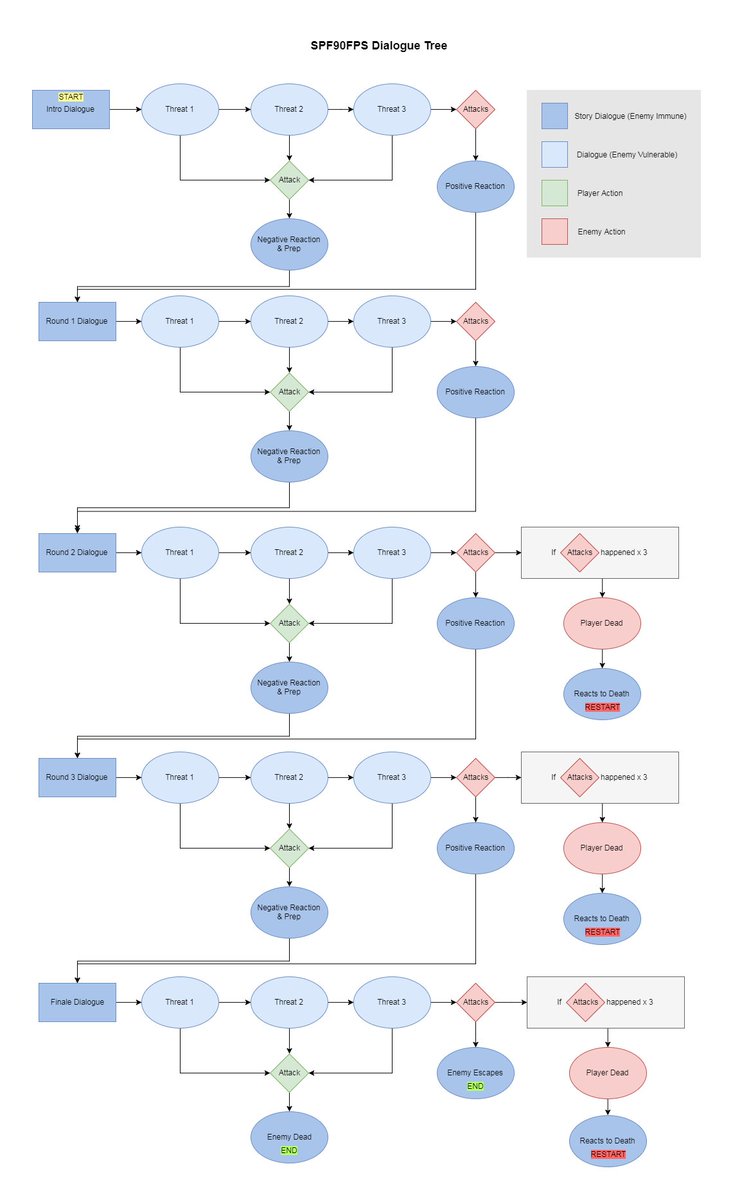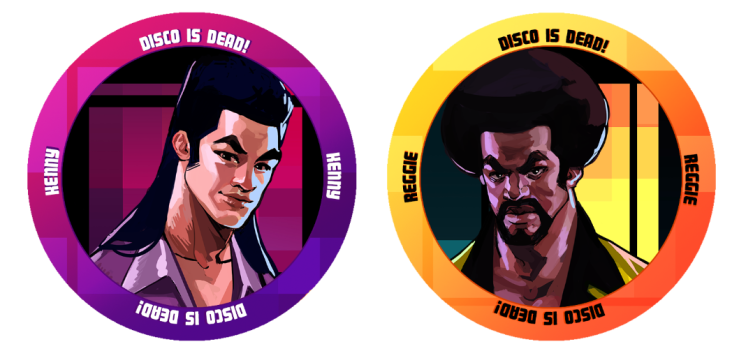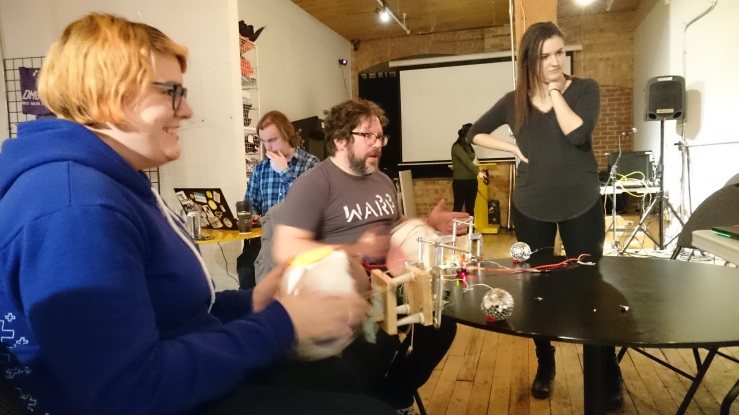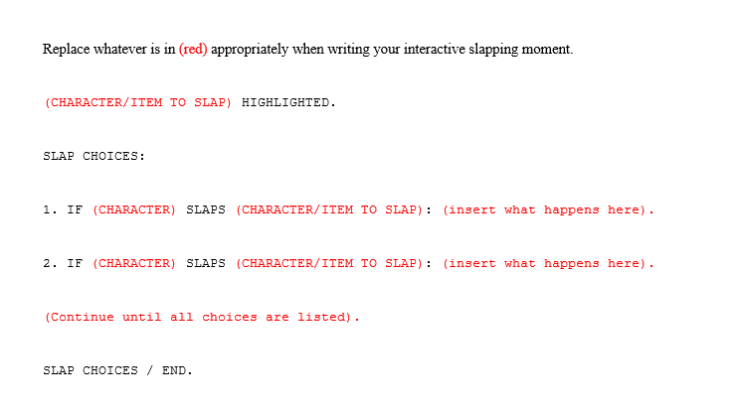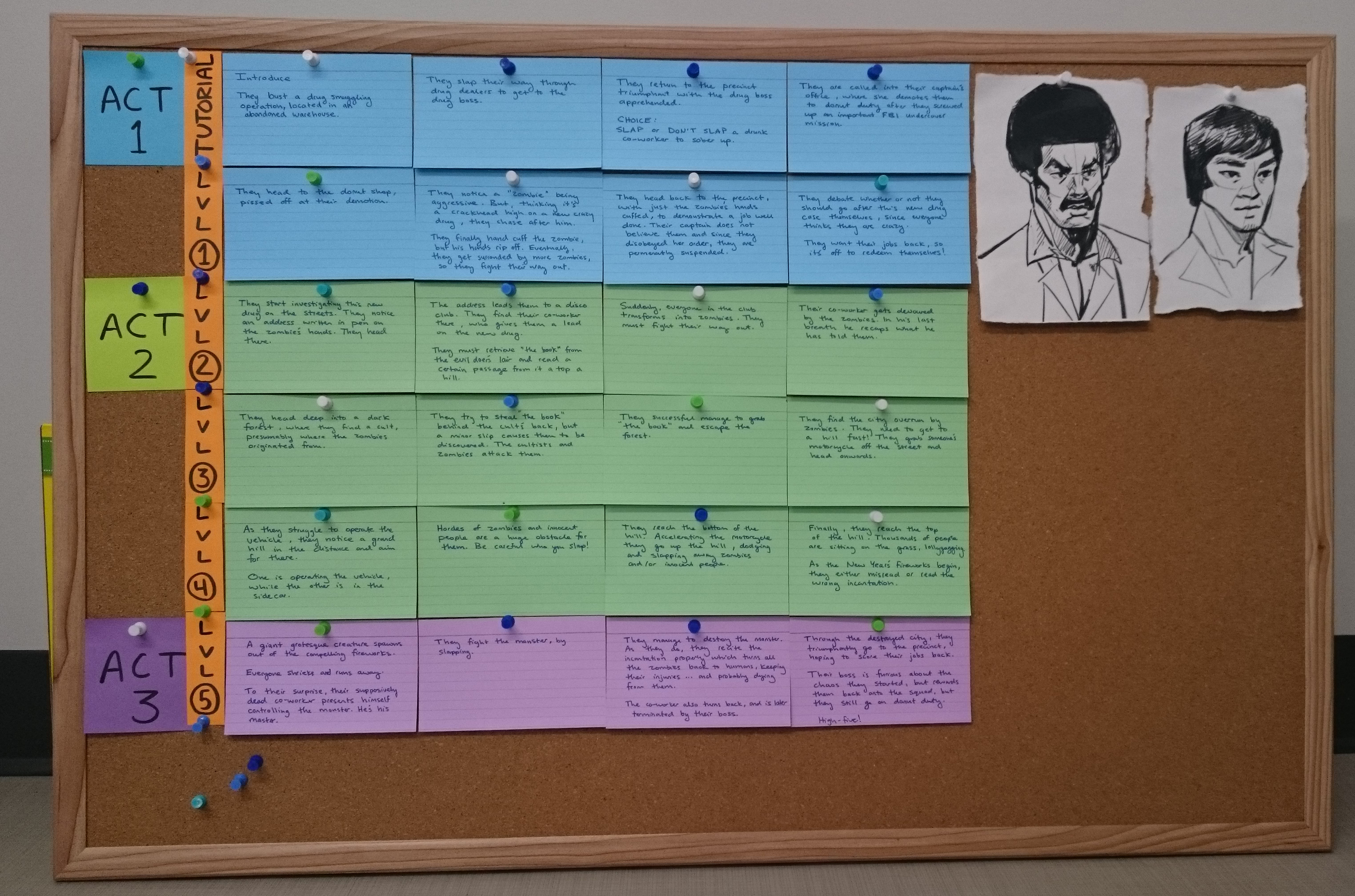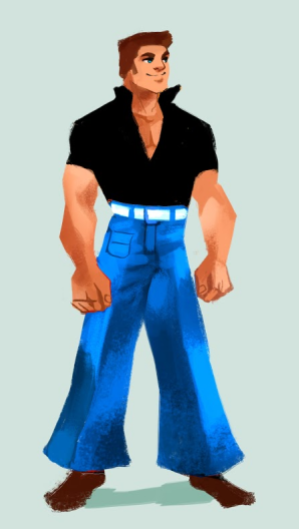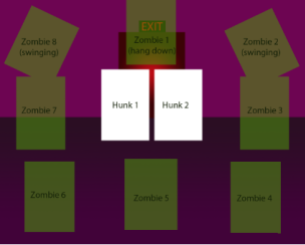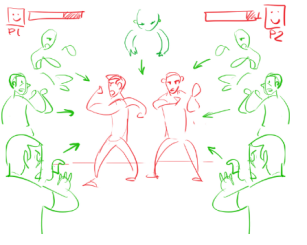Roughly three weeks into my one-month VR development journey, I was able to quickly conduct four playtest sessions at Gamma Space. This was a few days before I recorded and implemented the final dialogue with my VO actor, so there was still robo voice at the time. The game played from start-to-finish, so that was a good time to start getting some feedback.
Playtesting Before Showcasing
What I then realized was that it was going to be hard testing out a VR experience that relied heavily on audio. So basically, I could not hear what the players hear. I asked for the testers to try to think-out-loud, but most of the time players were listening to the audio… so I guess they were immersed enough that they didn’t want to talk out of the experience? I’m not sure. I had a visual cue of players successfully attacking Todd the ghost with a 3D model of him pop up for a second. To indicate when the player is able to stab Todd, I’ve designed it so that when the lights turn off, and dramatic music starts playing, the player is able to stab Todd.

Visual feedback of successfully stabbing Todd.
Here’s some of the notes I’ve jotted down from each of the testers:
Tester 1
Behavior during experience:
- This tester wanted to poke instead of stab Todd. She would slowly move the controller towards where she think Todd is, and when she saw him, she’d sweetly say “poke!”
- Smiling throughout experience.
Feedback after experience:
- Hard to hear music I’ve placed to indicate that’s when player’s can able to stab Todd. Crank it up!
- Lighting needs to be more dramatic and obvious if it’s to be used as a visual indicator the player is able to stab Todd.
- Todd’s dialogue help indicate when to stab as well. When he says “Come at me!” you know you can do that. Narrative can help this tremendously.
Tester 2
Behaviour during experience:
- Laughing at start and throughout.
- First time stabbing ghost, she screamed pretty loudly and was surprised. Afterwards said with an evil tone “Ahha, I wanna mess with you!”
- “Hiya!” was said when stabbing.
- Flailing arm around the entire time Todd was moving. Tester though she could stab when he’s moving (player can’t, Todd is immune when he’s moving).
- Eventually started stabbing through the entire game and moving around the space, instead of staying stationary.
- Freaked out Todd’s voice was closer to her so suddenly (this is when players can stab Todd).
Feedback after experience:
- Colour-coding the walls helped with player alignment.
- Could not figure out that Todd was placed in the centre of the walls.
Tester 3
Behaviour during experience:
- Lunged right into Todd, a perfect strike.
- Then proceeded to lunge at all directions all the time. Eventually stabbed Todd when the trigger box finally became available.
- Laughing.
- Continued to stab at all directions.
- Continued fierce lunges.
Feedback after experience:
- Floor was a little high-up. Probably something to do with scaling or the camera position.
- Voice-over was hilarious (at the time this was robo voice) and interactive.
- Player wishes that when you stab Todd, he moves to a different location instantly rather than stay where he got stabbed.
- Add SPX or audio cue when player successful stabs Todd.
- Add reverb/mix channel to Todd’s voice when he’s hit.
- Player felt that he had to stab right away, thinking it was a time-sensitive event. Which is why he kept trying to stab all the time.
- Player had a dilemma: He wanted to listen to Todd, but he also wanted to stab him. Is this a good dilemma to have?
Tester 4
Behaviour during experience:
- Player was ready to stab in the intro office scene. He was in his stabbing pose, ready to lunge.
- “Yeah, fucking Brad!” player agreeing to Todd’s profanity.
- “Whatta foul-mouthed ghost.”
- Thought Todd was above him.
- Rotating around, walking around room.
- Player did not lunge or try to stab ghost. Did not know when he was able to do it. Kept waiting around for a cue. Had to tell player he can stab now.
- “Got you, bastard!” Game encourages player to use vulgar language.
- Decided to “scan” the room like how one with use the controller to set up room-scale in VR. Holding the controller out and outlining the room to find Todd.
- Then started to stab all the time, constantly.
Feedback after experience:
- Cue to stab is needed.
- Particle effects, lens flare, or a glow could help determine when the ghost is nearby.
- Colour or pulse effect can help let players know there is a spiritual presence.
- Floor is high-up.
Iterations Needed
Because that week was the last and I had to focus on getting the recordings produced, edited and implemented, these iterations were not implemented before Damage Camp. What to work on next is:
- Players shouldn’t be told to stay stationary. How can I design it so that players will know to remain stationary in the centre and are welcome to lung forwards?
- Lighting, music and other visual cues need to be more obvious to let player know when they are able to stab Todd. Most players think they can stab him at anytime, even when moving.
- Visual cues to help hint to player they need to stab in the centre of the walls. Or should Todd’s positions be placed diagonally in the corners of the room?
- Add more dialogue lines as cue help player know when they are able to stab him.
- Adjust floor to avoid player disconnect or motion sickness.
Set Up Flaw & Emergency Design Implementation
Setting up the day before the showcase, the game was all well and functioning. Except one thing that I anticipated early on, but it still proposed a problem at the party. And that was of course, the audio.
Because the game relies on spatial audio and the player needs to hear in order to play the game, the venue was echoing everyone’s voice so it was very loud. Again, I predicted this would happen, so I bought expensive noise-cancelling headphones. But even with that, the computer’s audio couldn’t go any louder, so the noise-cancelling function could not work as well because it needs the audio to be loud in order for it to work. Even with just around 6 people in the room setting up and talking, it was really loud. So I had to quickly come up with some sort of solution.
In my game I designed it so that Todd is quieter when is immune because he is moving around the player from a further distance. That way when he is up-close to the player (vulnerable), the player knows they can stab now. However because it was hard to hear the immune dialogue, I decided to boost up all the audio files so that everything is at 1. So now, the distant quieter (immune state) audio is now at the same volume as the stationary and close audio (vulnerable state). Basically, now the players would be unable to tell when they are allowed to stab Todd because the volume for all the dialogue lines was the exact same.
I quickly decided to throw in a dramatic light effect to help with this. I threw in a few nodes into uScript to do the following:
- If Todd is close to the player and vulnerable: Turn ON a pink spotlight underneath the player.
- If Todd is far away, moving around and immune: Turn OFF the pink spotlight.
This was an emergency design decision thrown in last-minute for the party. As long as the player doesn’t have a tough time understanding the game, that’s all that matters to me.


Game set-up at Damage Camp.
Night of the Party
The night before the party, I forgot to leave a build behind on my computer, so when I arrived late to the party, I had friends huddling around my computer browsing through my Unity project trying to find the correct scene file to play. Whoops.
The event was to celebrate our success in creating our first VR prototypes, (and be one of the first artists to showcase work at TMAC!) so I did not have to worry about playtesting… but I wanted to anyways. So I conducted very informal playtests here and there throughout the night. Jotting notes was too much work that night, so I decided to easily film people playing to understand their actions, behaviors, facial expressions and movements.
Playtester playing the game at the opening party. Note how player tries to stab at all directions and had to squeeze headphones in ears to hear better.
Before someone wanted to play the game, I had to made sure to state various things before they are given the headset in order to provide them with an optimal experience.
- Stand in the centre of the space. Stay stationary throughout the game, however you are encouraged to lunge forwards to stab the ghost.
- Due to the loud environment it will be hard to hear the audio. Try to listen carefully to pinpoint where it is coming from.
- When the pink light is lit under you, that means you are now allowed to stab the ghost.
- Aim for the centre of the walls. The ghost is not in the corners.
I did not want to state the last one… but for a better play experience I had to. Some players were spending so much time stabbing at the wrong area that Todd stopped talking, which means they lost his position and got stumped.
Informal Conclusions
Very similar to the previous playtest obviously, but some other things to note:
- When Todd is vulnerable, players kept stabbing at all directions, because they could not figure out where he was due to the volume of the party outside of VR.
- Most players squeezed the headphones into their ears when not stabbing to try to hear the dialogue and pinpoint Todd’s location.
- Because this was a casual social event, players were not comfortable expressing criticism or feedback. Almost every person after playing said something among the lines of “That was soooo cool” and quickly proceed to leave.
- Players were laughing and smiling.
- Players found enjoyment in the dialogue, most expressed their condolences about the unfortunate audio situation.
- Bystanders were recording others playing the game and enjoyed watching.
Potentially Making It More Accessible #A11y
Recently, I went to the Game UX Summit hosted by Ubisoft Toronto and learned a tremendous amount of content in regards to how to make one’s game more accessible through game, UI and UX design. Bryce Johnson, a designer at XBox, talked particularly about how to make a card game accessible to a player who is blind or has low-vision, and even presented videos of how this sort of gameplay would look like. Later on in the summit, there was a panel that even included Steve Saylor, a blind gamer. Hearing from a user at a panel was heart-warming and really helps put this into a better perspective.

Inclusivity & Accessibility Panel at the Game UX Summit in Toronto, ON.
With this VR game, it heavily relies on audio. The player needs to listen to where the ghost is in order to figure out it’s location, and then proceed to attack. Even there will be more visual cues to help players out, the game seems like it has the potential to be playable by a player who is visually impaired or blind. Obviously, I cannot make assumptions as to how this sort of user would interact with the game. So in the future, I hope to have the opportunity to find a tester who is visually impaired or blind to be able to see how they play this VR experience, and to iterate on it’s design to make it more accessible towards this audience.











